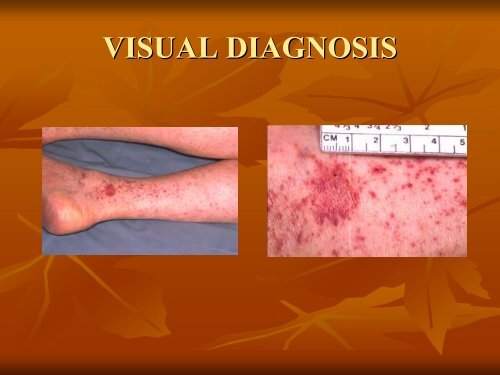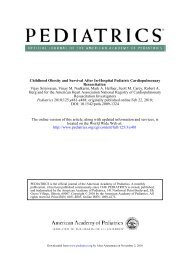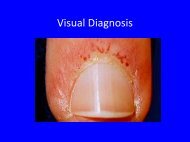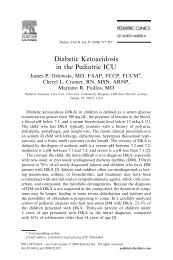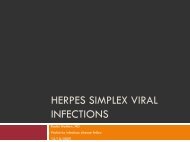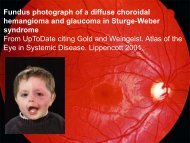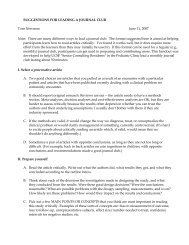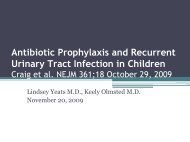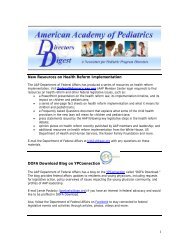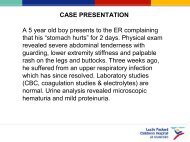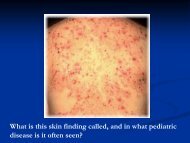VISUAL DIAGNOSIS VISUAL DIAGNOSIS
VISUAL DIAGNOSIS VISUAL DIAGNOSIS
VISUAL DIAGNOSIS VISUAL DIAGNOSIS
You also want an ePaper? Increase the reach of your titles
YUMPU automatically turns print PDFs into web optimized ePapers that Google loves.
<strong>VISUAL</strong> <strong>DIAGNOSIS</strong>
A “ spidery ” rash<br />
Lindsay Jackson, MD<br />
October 14, 2009
Case of a “spidery “ spidery” ” rash<br />
3 year old male develops a spidery rash over<br />
the past week on his arms and legs<br />
3 year old male develops a spidery rash over<br />
Bruising noted over lower extremities<br />
Dried blood noted at ears, nose<br />
“Blood “ Blood blister” blister ” on lower lip
Purpura
The “spidery “ spidery” ” rash
Exam<br />
Growth parameters and vital signs normal<br />
Well appearing<br />
HEENT: ecchymosis over left eye, crusted<br />
blood in nares, palatal petechiae<br />
HEENT: ecchymosis over left eye, crusted<br />
Abdomen: no hepatosplenomegaly<br />
Skin: petechiae on arms, back, legs. Pretibial<br />
bruising<br />
Skin: petechiae on arms, back, legs. Pretibial
Differential Diagnosis<br />
What causes thrombocytopenia (platelet count<br />
below 150,000) in children?<br />
What causes thrombocytopenia (platelet count<br />
Idiopathic thrombocytopenic purpura<br />
Drug induced thrombocytopenia (heparin)<br />
TTP<br />
Sepsis/DIC<br />
Congenital<br />
TAR (Thrombocytopenia, absent radii)<br />
Kasabach Kasabach Merritt Merritt<br />
Wiskott Wiskott Aldrich Aldrich
Labs<br />
WBC 7.3 (29% neutrophils, 63% lymphocytes,<br />
6% monocytes, 2% eosinophils)<br />
WBC 7.3 (29% neutrophils, 63% lymphocytes,<br />
Hemoglobin 11.9 with Hematocrit 34.4<br />
Platelet count 2000<br />
Chemistry panel<br />
Chemistry panel<br />
Na 132, K 5.6 (Hemolyzed) and LDH 473<br />
Liver function studies normal
Figure 2. Peripheral smear in a patient with ITP showing an almost total absence of platelets<br />
Lazarchick, J. ASH Image Bank 2001;2001:100177<br />
Copyright ©2001 American Society of Hematology. Copyright restrictions may apply.
Idiopathic Thrombocytopenic<br />
Objectives<br />
Purpura (ITP)<br />
Objectives<br />
Know function and life span of platelets<br />
Describe the usual presentation and laboratory<br />
tests in the child with ITP<br />
Describe the usual presentation and laboratory<br />
Review the treatment options<br />
Know the usual prognosis
Normal peripheral smear<br />
Normal platelets are one fifth the<br />
diameter of erythrocytes.<br />
They survive in the body for 9 to 10<br />
days
Idiopathic Thrombocytopenic<br />
Purpura (ITP)<br />
Estimated to be one of the most common<br />
acquired bleeding disorders encountered by<br />
pediatricians<br />
Estimated to be one of the most common<br />
3 to 8 cases per 100,000 children per year<br />
3 to 8 cases per 100,000 children per year<br />
A general pediatrician can care for most<br />
children with ITP<br />
A general pediatrician can care for most
ITP<br />
Autoantibodies (usually IgG) are directed against<br />
platelet membrane antigens<br />
Autoantibodies (usually IgG) are directed against<br />
Antibody Antibody coated coated platelets have a shortened half half life life<br />
because of accelerated clearance by tissue<br />
macrophages in the spleen and other portions of the<br />
reticuloendothelial system.<br />
The net effect is a decrease in the platelet count.
IgG coated Platelets
Presentation<br />
Most common in ages 2 to 5<br />
Characterized by the sudden appearance of<br />
bruising/bleeding/petechiae in an otherwise<br />
healthy child<br />
Characterized by the sudden appearance of<br />
Association with prior infection<br />
Association with MMR vaccination
Petechiae in ITP
Pertinent Negatives<br />
No systemic symptoms<br />
Absence of lymphadenopathy and<br />
hepatosplenomegaly on exam<br />
No evidence of hemolysis<br />
Absence of lymphadenopathy and<br />
No evidence of hemolysis
Laboratory findings<br />
Platelet count typically below 30,000<br />
15% of patients will have mild anemia due to<br />
bleeding<br />
Essential to review peripheral smear<br />
15% of patients will have mild anemia due to<br />
Essential to review peripheral smear<br />
Large platelets
Leukemia<br />
Leukemia<br />
What do parents fear?<br />
In one study of 2239 patients with newly<br />
diagnosed ALL, NONE exhibited isolated<br />
thrombocytopenia<br />
Bone marrow examination not necessary in routine<br />
cases<br />
In one study of 2239 patients with newly<br />
Bone marrow examination not necessary in routine<br />
Dubansky AS, Boyett JM, Falletta J, et al: Isolated thrombocytopenia thrombocytop enia in children with<br />
acute lymphoblastic leukemia: A rare event in a Pediatric Oncology Oncolo gy Group study.<br />
Pediatrics 1986;77:49
Chronic ITP<br />
Thrombocytopenia lasting longer than 6<br />
months<br />
Thrombocytopenia lasting longer than 6<br />
Thyroid studies<br />
Thyroid studies<br />
ANA<br />
Coombs test<br />
HIV/CMV/EBV<br />
Immunodeficiency
Pharmacologic Therapy<br />
70 to 80 percent of children with ITP will recover<br />
within a few months of presentation with or without<br />
treatment<br />
70 to 80 percent of children with ITP will recover<br />
Most patients do not have serious bleeding including<br />
those with platelet counts
Pharmacologic therapy<br />
IVIG<br />
Steroids<br />
Anti Anti Rh(D) Rh(D) (Win Rho)<br />
Splenectomy
Patient follow up<br />
Patient admitted overnight and given IVIG<br />
Platelet count after IVIG increased to 97,000<br />
Discharged with a note for preschool (activity<br />
restriction)<br />
Discharged with a note for preschool (activity<br />
Instructed to avoid aspirin, NSAIDS
Platelet counts<br />
Patient Follow Up<br />
Platelet counts<br />
2,000 (admit June 6, 2008)<br />
97,000 (June 10)<br />
67,000 (June 24)<br />
25,000 (July 11)<br />
70,000 (August 8)<br />
140, 000 (October 14)<br />
472,000 (January 29, 2009)
Questions?<br />
Free YOGA class tonight!<br />
6:15pm, Third floor LPCH in the<br />
physical therapy rooms (near the<br />
MD workroom just off 3 South)<br />
Thank you Mark Halpert for<br />
teaching!
References<br />
Steuber, C. Treatment and prognosis of immune<br />
(idiopathic) thrombocytopenic purpura in children.<br />
UpToDate online.<br />
Buchanan, G. Thrombocytopenia During Childhood.<br />
Pediatrics in Review 2005;26:401<br />
2005;26:401 409 409<br />
Chu, Y et all. Itopathic Thrombocytopenic Purpura.<br />
Pediatrics in Review 2000;21:95 2000;21:95 101 101<br />
Buchanan, G. ITP: How much treatment is enough?<br />
Contemporary Pediatrics 2000;14: 112 112 121 121<br />
Steuber, C. Treatment and prognosis of immune<br />
Buchanan, G. Thrombocytopenia During Childhood.<br />
Chu, Y et all. Itopathic Thrombocytopenic Purpura.<br />
Buchanan, G. ITP: How much treatment is enough?


